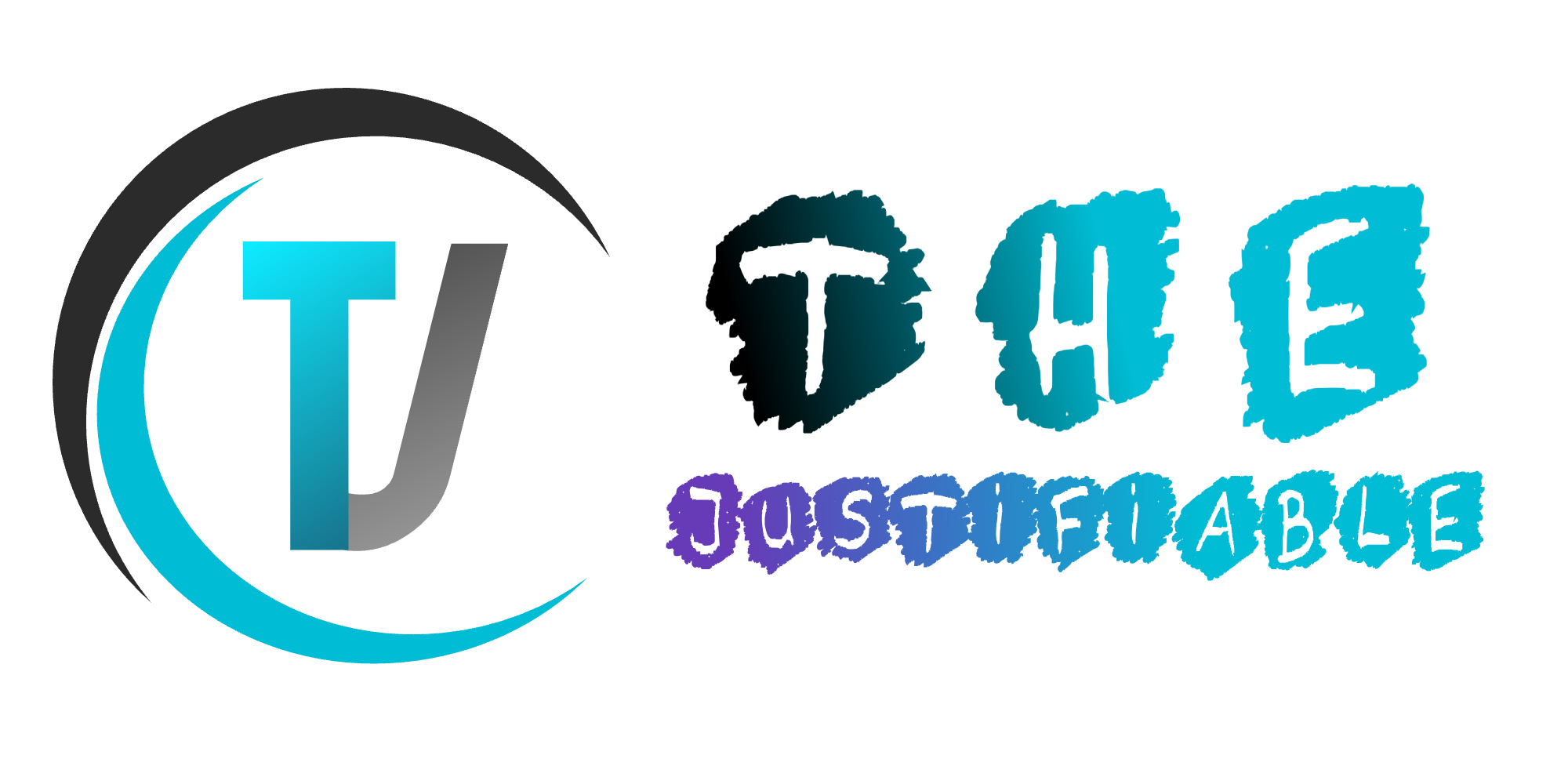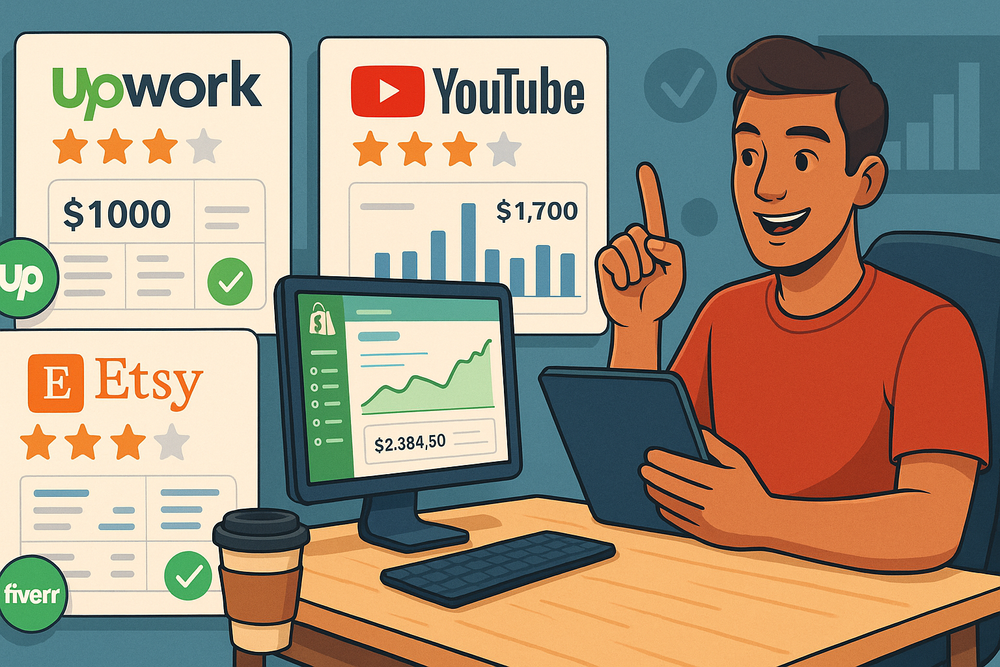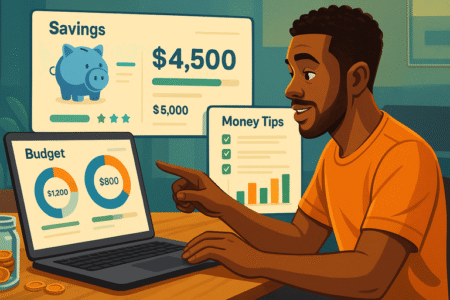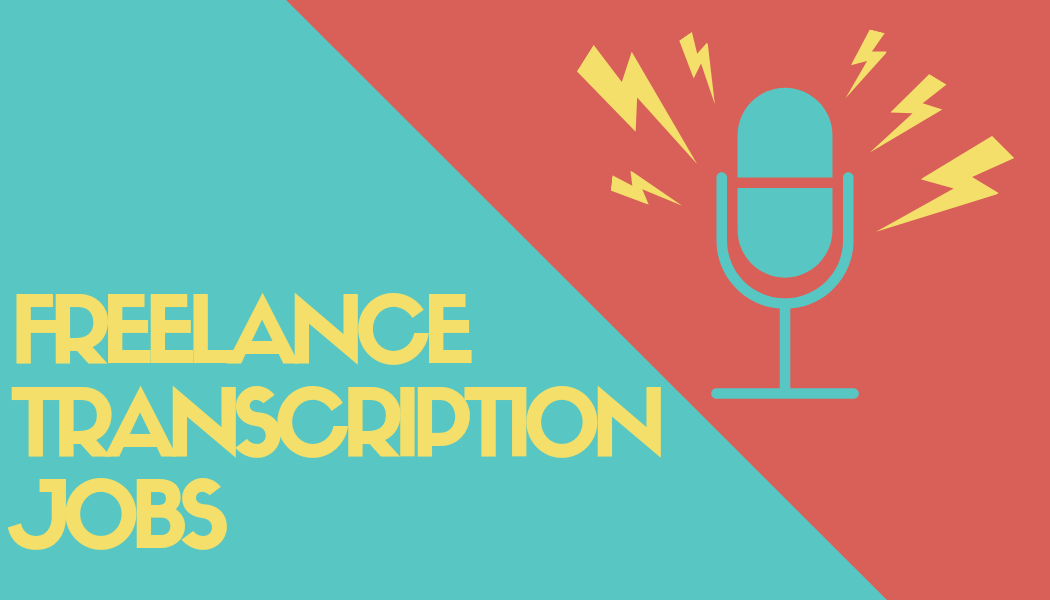Table of Contents
Looking for real ways to earn before it’s too late? You’re not the only one. Maybe you’re watching the bills pile up, feeling stuck in a job that’s going nowhere, or just tired of putting things off until “someday.”
What if you could start today—with what you already know, have, or can learn quickly?
Is there something you can launch fast, even without a big following or upfront cash?
How do you turn small actions into income, especially when time is tight?
In this guide, I’ll break down practical, proven options you can actually act on now. Whether you want quick cash or something more scalable, you’ll find a path that fits your goals—and your urgency. Let’s dive in.
Launch a Digital Product That Solves a Real Problem
Creating a digital product might sound overwhelming, but it’s one of the most sustainable ways to earn online. If you focus on solving a real problem for a specific group of people, you’ll stand out—even in a crowded market.
Identify a Pain Point in a Niche You Know
The sweet spot lies where your knowledge meets someone else’s frustration. You don’t need to be a world-class expert—just a few steps ahead of your target audience.
Here’s how to pinpoint the right problem:
- Think back to questions people often ask you. These are gold.
- Join niche Facebook groups, Reddit forums, or Quora threads and look for repeated complaints.
- Use tools like AnswerThePublic or AlsoAsked to explore what people are searching for around a topic.
For example, if you’re a fitness coach who specializes in helping busy moms stay active at home, a product like “10-Minute Fat Burners for Moms Who Hate the Gym” can speak directly to that struggle.
Use AI Tools to Rapidly Build an MVP or Resource
You don’t have to start from scratch. AI tools can speed up the creation process dramatically.
- ChatGPT can help outline or write the first draft of an eBook or guide.
- Canva makes it easy to design workbooks, cheat sheets, or visual guides.
- Tella lets you record bite-sized video lessons without fancy equipment.
The goal isn’t perfection. It’s speed + clarity. You want a minimum viable product (MVP)—just enough to get real feedback.
Promote on Gumroad, Podia, or Your Own Website
You don’t need a full-blown ecommerce store to sell. Start lean.
- Gumroad is excellent for creators selling simple digital products.
- Podia works well if you plan to expand into online courses or memberships.
- A personal blog or landing page with Stripe integration gives full control.
Make sure you:
- Write a clear, emotionally-driven product description.
- Include testimonials or a preview if you have one.
- Offer a limited-time bonus or discount to drive early action.
Turn Early Feedback Into Sales-Boosting Refinements
Your first version is just the beginning. Pay close attention to customer responses:
- What did they love or finish fast?
- Where did they get stuck or lose interest?
- Did they ask questions you didn’t answer?
Use surveys, follow-up emails, or direct chats to gather insights. Then update your product to reflect what people actually need—not what you assumed they needed.
This is where many quit, but it’s also where most success stories are born.
Pro Tip: Screenshot kind words or constructive feedback and turn them into testimonials for your landing page. You’re building trust while improving the product.
Offer a High-Demand Freelance Skill on Platforms
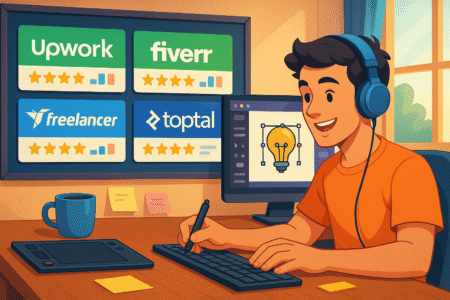
Freelancing remains one of the fastest ways to earn income without building a huge audience or product. If you’ve got a skill others need, platforms like Upwork and Fiverr can help you get in front of people actively hiring.
Choose Skills Like Copywriting, SEO, or Video Editing
Certain skills are always in demand—especially in the business, content, and marketing space. Here are a few worth considering:
- Copywriting: Crafting emails, landing pages, product descriptions.
- SEO Optimization: Helping websites rank higher and drive organic traffic.
- Video Editing: Making YouTube videos, short reels, or course content.
Even if you’re not a pro, you can niche down. For example: “I write email welcome sequences for fitness coaches” or “I edit TikTok videos for parenting influencers.” That clarity makes you more hireable.
Set Up Profiles on Fiverr, Upwork, and Contra
Each platform has its own vibe:
- Fiverr is great for set-price gigs and fast turnover.
- Upwork works better for long-term or hourly projects.
- Contra focuses on creative professionals and gives you 100% of your earnings.
Tips for a strong profile:
- Use a clean, friendly photo.
- Write a headline that says exactly what you do and who you help.
- Include portfolio samples—even if they’re mock projects or past personal work.
Your first few clients are crucial, so overdeliver in those early gigs.
Package Offers That Target Urgent Business Needs
People don’t just want skills—they want outcomes. Create service packages that solve common business headaches.
Examples:
- “SEO Blog Posts That Rank for Low-Competition Keywords”
- “Edit 3 Short-Form Videos With Captions in 48 Hours”
- “Landing Page Copy That Converts Cold Traffic”
Naming your package around the result helps you stand out. You’re not selling work—you’re selling solutions.
Use Social Proof and Fast Delivery to Build Trust
When starting out, speed and reliability can help you win repeat business. Always:
- Meet or beat your delivery deadline.
- Ask happy clients for a review or testimonial.
- Turn a one-time gig into a long-term retainer by suggesting follow-up work.
You can also build a simple one-page website (using Carrd or Notion) with your top projects and reviews. Link it from your profile—it adds legitimacy fast.
Expert Tip: Reach out to small businesses in your area and offer a discounted project in exchange for a testimonial. Local clients are often easier to land early on and more likely to refer you.
Start a Hyper-Niche Affiliate Blog or Newsletter
Affiliate marketing can feel overwhelming at first—but when you narrow your focus and speak to a very specific audience, it becomes much easier to earn trust, clicks, and commissions. This is one of the smartest ways to earn over time with content you can grow and monetize at your pace.
Pick a Narrow Audience With Buyer Intent
Instead of going broad, zoom in on a very specific problem or audience. The more focused your content, the more likely readers are to take action.
Examples of hyper-niche audiences:
- New dads looking for home workout gear
- Remote workers building ergonomic desk setups
- Teachers searching for side income tools
To make this work, pick a group that already wants to buy something. If you’re unsure, type a topic into Amazon or Google and see how many product-based results show up. Forums like Reddit and communities like Facebook Groups are great for listening in on actual buyer language.
When people feel like your content was written just for them, they’re more likely to trust your recommendations.
Use SEO to Target Keywords With Commercial Value
The backbone of long-term affiliate success is traffic, and SEO gives you a cost-effective way to build it. You want to find keywords that show someone is ready to buy—not just browse.
Look for keyword intent by checking for:
- Words like “best,” “vs,” “review,” “coupon,” or “top tools”
- Search results filled with product pages or review blogs
- Google Shopping or affiliate ads in the results
Free tools like Ubersuggest, LowFruits.io, or Keywords Everywhere can help spot these phrases. Focus on low-competition keywords that larger sites overlook. That’s where you can win as a smaller blog or newsletter.
For example, instead of “best standing desks,” go for “best standing desk for tall people under $300.”
Promote Affiliate Products With Storytelling, Not Spam
Nobody likes a pushy affiliate blog. What works is a blend of story + recommendation + honest insight.
Try this structure:
- Start with a personal challenge or relatable situation
- Explain what you tried and why it didn’t work
- Introduce the product that helped you solve the problem
- Walk through how it works, how it felt, and what results it delivered
- Include your affiliate link in context—not as a hard sell
If you haven’t used the product yourself, be transparent. Share what you’ve researched and how it stacks up against alternatives.
Use visuals, screenshots, or comparison tables to give the reader something real to look at. You’re helping them decide, not just click.
Use Beehiiv or Substack to Grow With Minimal Tech
Starting a blog takes time, but pairing it with a newsletter gives you a faster way to build trust and keep readers coming back.
Platforms like Beehiiv and Substack are simple, free, and designed for creators who want to write—not manage tech. They let you:
- Build a clean landing page in minutes
- Collect emails and segment readers
- Monetize through affiliate links, upgrades, or subscriptions
Instead of waiting for SEO to kick in, you can use newsletters to test affiliate angles, share your latest posts, or run mini product roundups. The feedback you get through email can also guide your next blog content.
Personal Tip: I suggest starting your newsletter before your blog. It’s faster to build a connection—and you’ll know exactly what content people actually care about.
Flip Low-Cost Digital Assets for Fast Profit
Flipping digital assets is one of the fastest and most overlooked ways to earn. It doesn’t require a big audience or a ton of time—just a keen eye for undervalued products and platforms with active buyers.
Buy Expired Domains With Traffic and Monetize
Every day, thousands of domains expire—and some still have backlinks, traffic, or niche authority. These domains can be bought for under $20 and turned into:
- Redirect links to affiliate products or your own blog.
- Simple one-page affiliate sites with Amazon or ClickBank links.
- Assets to resell on marketplaces like Namecheap Auctions.
Tools like SpamZilla and ExpiredDomains.net can help you spot valuable opportunities. Look for domains with:
- Clean backlink profiles (no spam)
- Keywords in the domain
- A history of real traffic or content
With minimal effort, you can redirect or relaunch the domain for quick income or long-term SEO benefit.
Resell Canva Templates, Notion Kits, or PLR Content
Digital products like templates are lightweight, scalable, and easy to personalize. If you’re good at design or organization, this is a quick win.
Here’s what people pay for:
- Wedding planning templates
- Notion dashboards for productivity
- Instagram post templates for coaches
- PLR (Private Label Rights) eBooks on niche topics
You can create these from scratch or buy low-cost licenses, rebrand them, and resell on your own site or Gumroad.
Make sure your designs are niche-specific and clearly solve a problem. Add a personal video walkthrough or use-case demo to increase perceived value.
Use Flippa or Etsy to Sell With Built-In Buyers
Selling is easier when the platform already has buyers. That’s where Flippa and Etsy shine.
- Flippa: Perfect for flipping starter blogs, domain names, or low-revenue sites. Even a basic blog with a few SEO-optimized articles and a clean theme can fetch $300–$1,000.
- Etsy: Ideal for selling templates, digital planners, or social media kits. Listing fees are low, and buyers often search for repeat-use items like wedding invites, course workbooks, or budgeting sheets.
You don’t need to be a graphic designer—just someone who understands what specific people are searching for.
Focus on High-Margin, Time-Efficient Assets
Your time is your most valuable resource. Prioritize digital assets that:
- Require little or no customer service
- Don’t need constant updates
- Can be sold many times over with one-time setup
Examples:
- A single Notion planner that sells 500+ times
- A blog with 10 solid articles sold for 4x what it cost to make
- A domain that redirects to a lead magnet or affiliate funnel
This approach can become a consistent side income stream if you treat it with the same care as flipping physical products—without the shipping, returns, or storage hassles.
Monetize Your Knowledge With a Mini Course
If you’ve achieved something others are still trying to figure out, you already have something valuable to teach. Creating a mini course is one of the most beginner-friendly ways to earn while genuinely helping others.
Pick a Skill You’ve Used to Get Real Results
You don’t need credentials—just a real-world outcome. The best mini courses are based on personal wins, especially when they’re repeatable.
Some easy course ideas:
- How you doubled your Etsy sales in 30 days
- How you learned budgeting as a freelancer
- How you improved your sleep without spending on expensive tools
These topics don’t need a full curriculum. If you can teach someone how to go from point A to point B using your method, you’re ready to package it.
To validate your idea, post in a small online group or message a few people who might want that result. If they show interest, that’s a green light.
Use Teachable or Skool to Launch Without Friction
You don’t need to code or hire a developer. Both Teachable and Skool make it incredibly easy to upload videos, organize modules, and manage student access.
- Teachable: Great if you want a clean layout and built-in sales pages.
- Skool: Combines a course with a built-in community and calendar. It’s like a course meets a mastermind.
Both platforms offer free trials, and you can launch your course in under a week using a slide deck, webcam, or even just screen recordings with voiceover.
If you want to skip platforms altogether, consider selling your course as a video download or private YouTube playlist with access sent via email.
Break Down Content Into Quick, Actionable Wins
People don’t want fluff. They want steps. Here’s how to structure it:
- Keep each lesson under 10 minutes
- Start with a promise (what they’ll learn)
- End with a prompt or mini task (something they can do today)
Structure example:
- Quick intro (why this matters)
- Core concept with a story or visual
- Example or tool you personally used
- Action step to apply the lesson right now
You’re not building a university lecture—you’re giving people tools they can use immediately.
Offer a Pay-What-You-Can or Beta Pricing Model
Starting small is a smart move. A beta launch does two things:
- It builds momentum without pressure
- It helps you gather testimonials before scaling
Here’s what you can offer:
- Free or “pay what you can” access to the first 10 people
- Lifetime access in exchange for feedback
- A live version via Zoom that you later turn into course videos
This soft launch builds confidence and shows future buyers that others have already trusted and used your content.
Pro Tip: Screenshot feedback or wins your first students share. These become your most powerful marketing assets later.
Use the Gig Economy to Generate Daily Cash
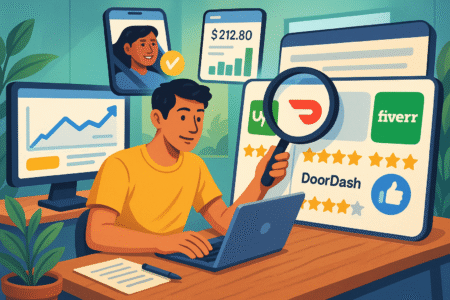
If you’re looking for fast income you can control, the gig economy is packed with low-barrier options. You don’t need a degree, and you can start today with just a phone and a flexible schedule.
Sign Up for Instacart, Rover, or TaskRabbit
These platforms let you earn by doing everyday tasks, with instant sign-up and training.
- Instacart: Shop and deliver groceries. You earn per trip, plus tips.
- Rover: Dog walking and pet-sitting jobs. Great if you love animals.
- TaskRabbit: Handle chores like furniture assembly, cleaning, or moving help.
You can apply and get started in 24–48 hours in most cities. These aren’t long-term careers, but they’re great for quick wins or bridging income gaps.
Create a Strategy to Maximize High-Tip Gigs
Not all gigs are created equal. Some offer better time-to-income ratios than others.
Here’s how to maximize:
- Choose high-density neighborhoods to avoid travel time
- Target weekend evenings when tips spike
- Accept bundled tasks to get more done in fewer trips
If you’re on Rover, offer extra services like pet bathing or overnight stays. On Instacart, aim for “batch orders” to boost per-hour rates.
Use Your Phone to Track and Optimize Routes
Navigation is everything. Use route-optimization tools like:
- Circuit Route Planner: Helps you batch deliveries
- Waze: Avoids traffic and finds shortcuts
- Google Maps’ Timeline: Tracks past deliveries to refine future plans
This helps you fit more gigs into less time. It also makes a big difference in fuel savings and faster turnaround.
Stack Apps to Earn from Multiple Streams Daily
You don’t have to stick with one platform. App stacking lets you take advantage of slow periods and combine income sources.
Example stack:
- Morning: Deliver for Instacart
- Afternoon: Walk dogs via Rover
- Evening: Do a home setup via TaskRabbit
By stacking, you spread risk and fill downtime without waiting for one app to assign you a job. Just make sure you manage your schedule well so you’re not overbooked.
Expert Insight: Many top gig earners schedule their week in advance based on peak demand times. Think of it like managing a client calendar—it adds structure and improves consistency.
Sell Unused Items or Dropship Easy-to-Ship Products
If you want to clear space and earn at the same time, reselling or dropshipping small items is a solid place to start. It’s fast, low-cost, and often overlooked as a serious income stream.
List High-Value Clutter on Facebook Marketplace
Your home is full of potential. Electronics, furniture, workout gear, and even tools can sell quickly on Facebook Marketplace.
To increase your chances of a sale:
- Use clear, natural-light photos from multiple angles
- Write honest, short descriptions (include dimensions)
- Offer local delivery for a small fee—it can increase sales
Start by going room by room and listing three items per day. The goal isn’t just decluttering—it’s learning how to sell, negotiate, and spot what people are willing to pay for.
Use eBay for Vintage or Niche Hobby Items
eBay is ideal for selling:
- Collectibles (cards, games, action figures)
- Used books or rare editions
- Tech accessories or tools
Niche items that are hard to find locally can sell for a premium. You don’t need fancy packaging—just bubble wrap and a shipping scale.
Set your listing to auction for rare items, and fixed price for fast-moving ones. Always check completed listings to see what similar items actually sold for.
Start a Shopify Store With Pre-Validated Products
If you want to move beyond one-time sales, dropshipping is a simple business model to test.
- Use tools like Ecomhunt, AliShark, or Sell The Trend to find proven products
- Set up a Shopify store with Appscenic or Spocket to automate order fulfillment
- Focus on lightweight, under-$30 products with a clear need (like back pain tools, posture correctors, or pet gear)
You won’t need inventory—just good copywriting, clear images, and a simple product page.
Focus on Fast-Moving, Low-Risk Inventory
Whether you’re selling personal items or dropshipping, your goal is to keep it lean. Avoid bulky, breakable, or seasonal items at first.
Look for items that:
- Ship easily in small packages
- Have consistent demand (not trendy fads)
- Solve clear, small problems
Over time, track what sells, what questions people ask, and what listings attract the most views. Use that data to grow smarter—not just bigger.

